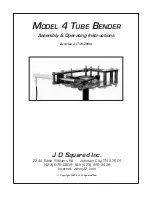
dbx Type IV™ Conversion System
White Paper
by Roger Johnson
The dbx Type IV™ Conversion System is a proprietary analog-to-digital (A/D) conversion process that combines
the best attributes of digital conversion and analog recording processes to preserve the essence of the analog signal when
it is converted to a digital format. dbx Type IV™ not only exploits the wide linear dynamic range of today’s A/D con-
verters, but also enhances it and extends the useable dynamic range beyond the linear range. By providing a logarith-
mic “Type IV™ Over Region” above the linear A/D range, we benefit from the extended high-level headroom that is
inherent in analog recording without compromising the noise performance of the A/D conversion process.
Digital conversion and recording processes proliferated in the 1980’s primarily due to the “cleaner” sound of dig-
ital versus analog, an advantage resulting from the comparatively wider linear dynamic range of digital. Anyone who is
familiar with the technical specifications of digital equipment knows that the typical maximum signal-to-noise specifica-
tions for 16-bit systems is in the neighborhood of 90-something dB. Compare this to the typical signal-to-noise specifi-
cations for professional analog tape of about 55dB without the aid of noise reduction and around 75 to 85dB with noise
reduction such as dbx Type I™ or Type II™ applied.
This seemingly tremendous signal-to-noise advantage of digital over analog would suggest that digital would
become the unanimous choice for recording. For the most part this has occurred, not totally due to its signal-to-noise
advantage, but as much due to the benefits of digital storage such as random access and the inherent ability to with-
stand degradation, unlike that of analog tape or LP’s. In spite of the benefits of digital, no one in the audio world can
refute the rediscovery of analog recording and tube gear that has occurred in the 90’s, attributable to the quest for that
“analog character” that is missing from digital recordings. This continued use of analog gear with modern digital systems
brings to light a favorable characteristic of analog recording which those who abandoned analog and jumped on the dig-
ital bandwagon were either never aware of or simply took for granted.
Anyone who has ever used analog tape knows that you can “hit it hard” without destroying the recording. The
printed specifications of analog tape don’t take into account the practical headroom available. The max signal-to-noise
specification of analog tape is measured by defining the “max” signal as the point where a given signal level and fre-
quency produces a given percent Total Harmonic Distortion (THD)—typically the level at which a 1 kHz signal produces
3% THD. In actual use, the signal can easily exceed this “max” signal level by 5, 10, or even 15dB on peaks, depending
on the type of signal being recorded, without unacceptable artifacts. High signal levels can be tolerated (i.e. more head-
room) at the expense of increased THD which, incidentally, is often desirable as an effect, evidenced by the renewed
popularity of tube equipment.
The obvious conclusion is that analog recording actually has more useable dynamic range than the specifica-
tions seem to indicate. For example, let’s say we’re recording a kick drum. If analog tape measures 55dB from the 3%
THD point down to the RMS noise floor and the peaks of the kick drum exceed the 3% THD level by, say, 15dB and it
still sounds good, then we have 15dB of extra useable headroom. Therefore, we end up with 70dB of useable dynam-
ic range. Throw in noise reduction and we push into the 90-something dB dynamic range territory of 16-bit digital. This
explains why well-recorded analog master tapes make good-sounding CD’s with no objectionable noise.
One main drawback of digital is that it inherently lacks this forgiving and beneficial characteristic of analog
recording. Although digital conversion exhibits wide linear dynamic range, when you run out of headroom for high-level
signals, hard clipping or even ugly signal wrap-around occurs, not to mention that A/D converters have their own nasty
side effects such as going unstable when their modulator is overdriven with high-level signals.
This shortcoming of digital conversion has drastically affected the way users operate their equipment. Users are
Type IV™ White Paper
Type IV™ White Papers
Appendix
ProVocal
™
19
ProVocal™ User Manual
Summary of Contents for ProVocal
Page 1: ...ProVocal User Manual Digital Vocal Processor...
Page 5: ...INTRO CUSTOMER SERVICE INFO ProVocal DEFINED WARRANTY INFO INTRODUCTION ProVocal...
Page 9: ...Getting Started Getting Started Section 1 ProVocal...
Page 13: ...DETAILED PARAMETERS BASIC OPERATION AND UTILITY Operation Section 2 ProVocal...
Page 21: ...APPLICATION GUIDE DIGITAL APPLICATIONS Section 3 ProVocal...
Page 25: ...APPENDIX BlockDiagram dbxTypeIV WhitePaper Specifications APPENDIX Appendix ProVocal...
Page 26: ...Block Diagram 18 Appendix ProVocal Block Diagram ProVocal User Manual...
Page 30: ...Type IV White Paper 22 Appendix ProVocal ProVocal User Manual...







































